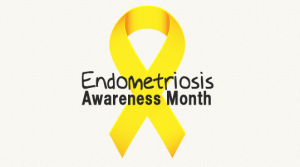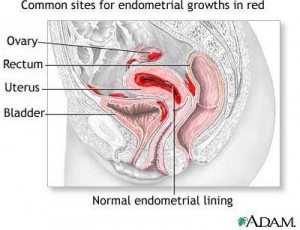
Endometriosis is a condition in which the endometrial tissue (the cells lining the uterus) grows in other areas of the body. The tissue growth typically occurs outside of the uterus, such as on the ovaries, fallopian tubes, bowel, rectum, bladder, and on the delicate lining or fascia of the pelvis. This tissue growth can cause adhesions, fibrous bands, and scarring in and around the pelvic organs and structures. Common symptoms of endometriosis include abdominal, hip, and pelvic pain, cramping, irregular bleeding, painful menstruation, low back pain, sacroiliac joint pain, bladder pain or painful urination, digestive problems, abdominal bloating, painful bowel movements, painful intercourse (dyspareunia), and can lead to infertility. Endometriosis can also be a cause of or related to pelvic floor muscle dysfunction. Endometriosis can lead to trigger points in the abdominal muscles and pelvic floor muscles causing even more pelvic pain. There are several theories as to why endometriosis occurs yet there is no known cause. The best way to approach endometriosis is through a multidisciplinary approach which includes a skilled and experienced physical therapist that specializes in pelvic pain and myofascial release techniques, including visceral mobilization. At Pamela Morrison Physical Therapy, your expert pelvic rehab specialist will perform an extensive medical history and a physical exam which would include specific testing of your pelvic structures. Joint alignment and mobility, connective tissue mobility, pelvic nerve function and mobility testing, pelvic organ mobility/motility are assessed as well as pelvic and abdominal muscle palpation to identify tender points, trigger points, and tightness. Areas of painful pelvic adhesions and scar tissue are easily identified via our skilled therapist’s connective tissue mobility and palpation tests. Rehabilitative real-time ultrasound and palpation can help identify pelvic floor muscle dysfunction. Based on the evaluative findings, a comprehensive treatment program will be initiated. Treatment techniques may include modalities for pain such as moist heat, TENS, ultrasound, or cold laser. Manual therapies such as myofascial release, scar release techniques, visceral (organ) manipulation, trigger point releases techniques, neural tension release techniques, and joint mobilization would be utilized. Other treatment approaches may include stretching exercises, therapeutic exercises, dilator therapy, and pelvic floor muscle rehab. Patients find significant or full relief after being treated at our practice.




